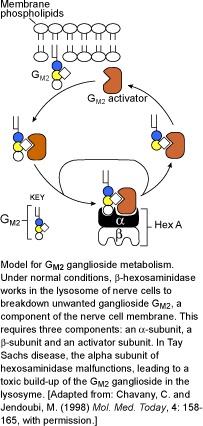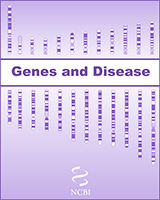NCBI Bookshelf. A service of the National Library of Medicine, National Institutes of Health.
National Center for Biotechnology Information (US). Genes and Disease [Internet]. Bethesda (MD): National Center for Biotechnology Information (US); 1998-.

Tay-Sachs disease, a heritable metabolic disorder commonly associated with Ashkenazi Jews, has also been found in the French Canadians of Southeastern Quebec, the Cajuns of Southwest Louisiana, and other populations throughout the world. The severity of expression and the age at onset of Tay-Sachs varies from infantile and juvenile forms that exhibit paralysis, dementia, blindness and early death to a chronic adult form that exhibits neuron dysfunction and psychosis.
Tay-Sachs is an autosomal recessive disease caused by mutations in both alleles of a gene (HEXA) on chromosome 15. HEXA codes for the alpha subunit of the enzyme β-hexosaminidase A. This enzyme is found in lysosomes, organelles that break down large molecules for recycling by the cell. Normally, β-hexosaminidase A helps to degrade a lipid called GM2 ganglioside, but in Tay-Sachs individuals, the enzyme is absent or present only in very reduced amounts, allowing excessive accumulation of the GM2 ganglioside in neurons. The progressive neurodegeneration seen in the varied forms of Tay-Sachs depends upon the speed and degree of GM2 ganglioside accumulation, which in turn is dependent upon the level of functional β-hexosaminidase A present in the body.
A mouse model has been developed for Tay-Sachs, although its usefulness is limited since Tay-Sachs mice possess a minor alternative pathway for breaking down GM2 ganglioside. Treatment of the late onset form of Tay-Sachs with a ganglioside synthesis inhibitor shows promise. The effectiveness this and other treatments on individuals with the infantile (the most common) form of the disease is extremely limited since the extent of neurological damage prior to birth is unknown. The difficulty in reversing such damage will make it hard to develop an effective treatment for the infantile form of the disease. It is hoped, however, that the latter onset forms of Tay-Sachs may prove responsive to treatment, and such treatment combined with the DNA and enzymatic screening programs currently in use will lead to the eventual control of this disease.
- Genome view see gene locations
- Entrez Gene collection of gene-related information
- BLink related sequences in different organisms
- Research articles online full text
- Books online books section
- OMIM catalog of human genes and disorders
- GeneReviews a medical genetics resource
- Fact Sheet from National Institute of Neurological Disorders and Stroke
- NTSAD National Tay-Sachs and Allied Diseases Association
- Tay-Sachs disease - Genes and DiseaseTay-Sachs disease - Genes and Disease
Your browsing activity is empty.
Activity recording is turned off.
See more...
